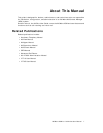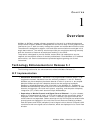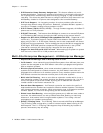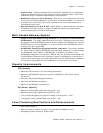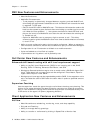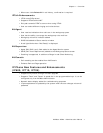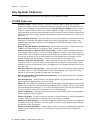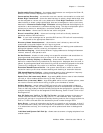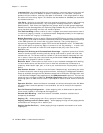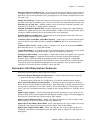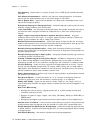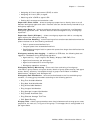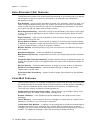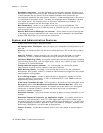Chapter 1: Overview
AltiWare ACM 5.1 Administration Manual 9
Configurable Phone Display - the system administrator can configure the Caller ID,
Name, or DNIS number displayed on a phone set.
Conversation Recording - an extension user can record a conversation to voice mail.
Dialed Digit Translation - allows the administrator to select a single dialed digit that
can be assigned to route a call to any destination. First Digit Translator allows the
administrator to select a single dialed digit that can be assigned to route a call to any
destination. Extension Dialed Digit Translator allows predefined dialed digits by an
extension to be translated into a different dialing string. The digit manipulation option
allows you to remove or add digits to a number dialed by the extension.
Dial Last Caller - allows user to dial the last caller using #69.
Direct Inward Dial (DID) - allows an incoming trunk call to directly access an
extension without IVR intervention.
Note: If your local exchange carrier provides DID service, DID calls will automatically
be steered to the appropriate destination.
Directory Name Announcement - the extension user’s directory name will be
announced to the caller before the call rings to a phone.
Distinctive Call Waiting Tone - allows three different call waiting tone cadences to
distinguish between internal, external, and operator calls.
Distinctive Ringing - allows three different ringing cadences to distinguish between
internal, external, and operator calls.
Do Not Disturb - blocks all calls coming into a specific extension and sends them to
preprogrammed destinations such as voice mail or the operator.
Extension Activity Display and Greeting - allows users to select from a set of pre-
defined or customized activity codes that can be played or displayed when the user is
absent. A greeting associated with the activity can be recorded and played to the caller.
The activity is displayed if the caller is an AltiView, AltiAgent, or IP phone user.
Extension Based Feature Profile - the system administrator is able to create an
extension feature profile that includes enabling and disabling of extension features.
FSK-based Message Waiting - allows message waiting that is based on frequency-
shift keying (FSK), a modulation technique for data transmission.
Hands Free (dial tone mute) Mode - by pressing #82, allows a user to leave handset
off-hook or use a headset without having to hear the dial tone.
Hands Free (Intercom) Mode - by pressing #81 while on their speaker phone, users
can receive internal calls without having to pick up the handset to answer.
Holiday Routing - routes inbound DNIS and trunk calls on designated holidays to
specified destinations. You can create separate routes for business and non-business
hours on half-day holidays. Multiple Holiday Profiles can be configured in a system. Also,
multiple Holiday Profiles can be assigned to DNIS Routing, Caller ID and Trunk In Call
Routing entries.
Hop Off Calls over VoIP or T1/PRI Tie Trunks - multiple systems at the same or
remote locations can be linked through VoIP or T1/PRI networks. Also, this feature
provides toll savings on long distance calls by allowing users to dial a remote system via
VoIP or T1/PRI trunk and then the destination phone number through PSTN.
Hunt Group - a group of extensions can be set up to perform call coverage, so that if
the first extension is busy, the next extension is hunted until a free extension is found.
If all extensions are busy, the incoming call will be queued and listen to background
music.
Individual and System Call Pick Up - allows users to answer a ringing telephone from
another station.



